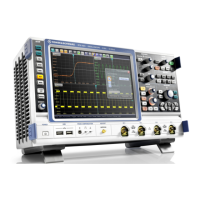Acquisition and Setup
R&S
®
RTO
18User Manual 1316.0827.02 ─ 06
2.1.2.3 Acquisition Control
You can run the R&S RTO in two ways:
●
Continuous: the instrument acquires data until you stop it manually.
●
NxSingle: the instrument samples and processes a specified number of acquisitions.
The determining point of an acquisition is the trigger. It defines the time-zero point in the
waveform record. The instrument acquires continuously and keeps the sample points to
fill the pre-trigger part of the waveform record. When the trigger occurs, the instrument
continues acquisition until the post-trigger part of the waveform record is filled. Then it
stops acquiring and waits for the next trigger. When a trigger is recognized, the instrument
will not accept another trigger until the acquisition is complete.
The trigger modes define how the instrument triggers:
●
Normal: The instrument acquires a waveform only if a real trigger occurs, that is, if
all trigger conditions are fulfilled.
●
Auto: The instrument triggers repeatedly after a fixed time interval if the trigger con-
ditions are not fulfilled. If a real trigger occurs, it takes precedence. If the real trigger
is faster than the auto trigger, both modes are virtually the same.
In practice, both trigger modes are useful: The auto mode lets you see the signal with
very little adjustment, while the normal mode selects the interesting part of the waveform.
If you want to acquire a specified number of waveforms with NxSingle, make sure to
select the normal trigger mode. Thus you get only the required number of interesting
acquisitions.
See also: chapter 3, "Triggers", on page 53
Basics

